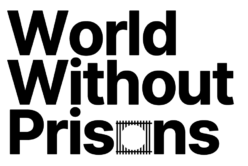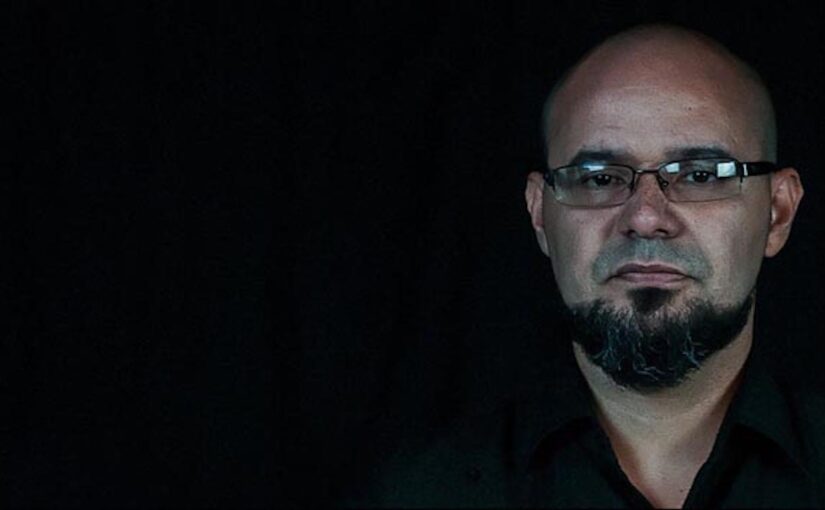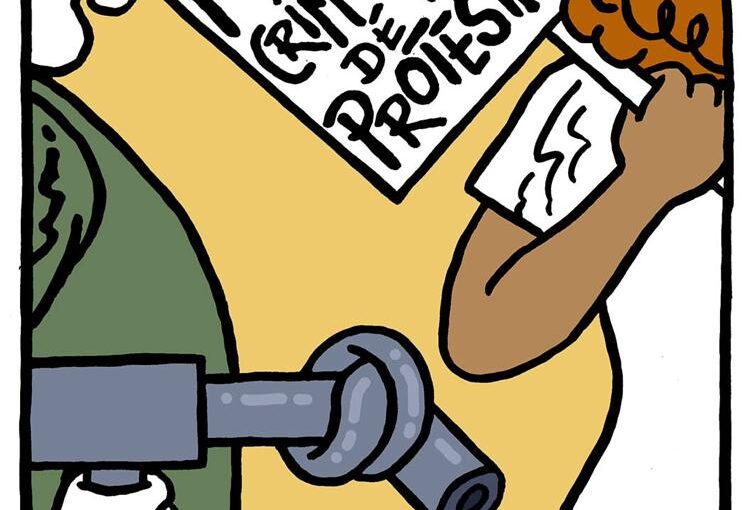Originally published in Venezuelan Voices
Professor Keymer Ávila is a Researcher at the Institute of Criminal Sciences at the Central University of Venezuela and a Professor of Criminology at the same university. He is one of the foremost scholars and critics of institutional violence and criminal justice policies in current Venezuela. In this interview, originally published on July 6 and 7 at No Borders News, Venezuelan Workers Solidarity members Elvira Blanco and Alejandro Quryat asked him about the nexus between racism and State violence in our country.
All notes between brackets are the translators’.
Photo credit: observatoriodeviolencia.org.ve
What forms does racial oppression take in Venezuela? What groups face systematic racialized discrimination?
The first thing I must clarify is that my field of research is not focused on the topic of race, but on institutional violence, specifically that of the criminal justice system. Criminal justice systems are characterized for being discriminatory, classist, racist and xenophobic. It is from this field that I can approach the topic of racism.
In a very general manner, what I can tell you is that racism in Venezuela is not admitted or owned up to as a problem, it remains nearly taboo. We’d be talking here of a latent, symbolic and cultural racism, that is presented as something folksy or comic, aesthetic, along with a cluster of prejudices, as well as subtle and indirect forms of oppression, discrimination, stigmatization and exclusion. These go from the non-recognition or hiding of one’s own African or Indigenous heritage, to self-discrimination. It’s the racism exercised by those who suffer discrimination themselves, in what is known as endoracism, a concept developed in our country by Esther Pineda. This is what makes it difficult to confront it. It doesn’t reach the institutionalized and extreme levels that it has in the U.S., but, no doubt, it waters the grounds to later legitimize other forms of violence against oppressed groups.
Who would be part of these groups? The poor, Afro-Descendants, and Indigenous people. Until a few years ago, when our country was receiving immigrants, Haitians, Trinidadians, Colombians, Ecuatorians and Peruvians were also part of these groups. By contrast, migrants from Spain, Italy and Portugal were given a much more privileged treatment. So it wasn’t just about xenophobia: there was implicit racism and classism against these peoples. Nowadays this situation is mirrored, since Venezuelans serve as scapegoats in many countries, given the enormous exodus of at least 13% of our population.
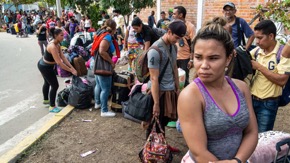
How do race and class intercross in Venezuela?
They are intimately linked, as in most of the colonial countries that exploited slaves brought from Africa between the 16th and 18th centuries. In the case of Venezuela, the upper classes and their traditional families – some dating back to colonial times – are predominantly white and endogamous, and do not intermarry. One can place the Italian, Spaniard and Portuguese migrants that came in the mid-20th century fleeing the world wars on a lower rung. They were welcomed as skilled laborers, and who were then able to ascend in the social scale. This migratory wave from Europe was promoted by the Pérez Jiménez government in an attempt to “modernize” and “whiten” the country, to “improve the race”. Some intermarried, although most did not. These then are the highest layers of society, which constitute a minority that owns important economic sources of power, but that nowadays are displaced from the center of politics.
Further down would be the majority of the country, which is fundamentally mestiza, of mixed white, Black and Indigenous origins. It is precisely this condition of identifying ourselves as the product of this blend is what makes it difficult for us to accept that we have problems with racism.
In the popular classes, there are more Afro-descendants and Indigenous people than in the middle classes. We can say that, in terms of mestizaje [denoting people of mixed-race backgrounds] our social structure is shaped like a rhombus or a diamond: as you approach either the top or the base there is less mestizaje , while in the middle layers it is much greater; moreover, the amount of melanin decreases at the top and increases as you move to the bottom.Therefore, in our country, class segregation tends to be deeply linked to racial segregation.
Was Chavismo an advance against racism?
Some could posit the 1998 electoral victory of Chávez as a symbolic success, because he was the first President of Indigenous and African descent and of a popular background in the country. However, class played more of a role than race here. As I mentioned earlier, the topics of race and class are intimately linked in Venezuela. On the part of the traditional Opposition, racist and classist discourses flourished. But two decades after this event, one cannot say that the most excluded classes are faring better than before, nor that this meant an empowerment of these sectors. On the contrary, today poverty, inequalities, exclusion and repression are greater.

In the present, under Nicolás Maduro’s regime, how do police or security forces interact with groups racialized or oppressed by racism? How do these forces respond when these groups organize for their rights?
When we denounce that in Venezuela police forces have been carrying out a drop-by-drop massacre against young people in popular sectors, we are referring to racialized and poor youth. Here, the criminal justice system is as racist and as classist as in other countries in the region. The main difference could lie in its high levels of deadly force.
The so-called forces of order, everywhere, are meant for the disciplining, control and repression of the popular classes, which ruling elites always consider dangerous. The real reason for their existence ––which is covered up by different types of discourses, predominantly normative ones, that invoke the general interest and public safety–– is, in essence, the protection of the few that hold political and economic power.
This all dates back to our colonial history. The Colony was always a police state. The arrival of the so-called ‘rule of law’ that would set limits and rules on power in the metropolis did not work in the same way in the peripheries. The inhabitants of the colonies were not considered citizens but savages, deprived of rights and subject to a state of exception. This idea is still deeply rooted in our countries. Thence come some of the justifications for the excesses of institutional violence, and especially that of the police.
In the specific case of Venezuela, the security forces have been marked from their origins by their militarization, their instrumentalization by political parties, and their excesses against the popular classes. The military logic that imposed itself in the confrontation with the [Leftist] armed struggle of the ‘60s and ‘70s, with thousands of cases of violations of human rights, was displaced in the following decades to the daily practices of security forces. Cases like the “Pits of Death”, the massacre of El Amparo, or the repression of the 1989 Caracazo rebellion would become emblematic of the last decades of the 20th century.
The twenty-first century in Venezuela came with promises of a radical change and a rupture with what preceded it. However, what ensued was a continuity and a deepening of everything that was already profoundly wrong.
According to official data analyzed in our studies, between 2010 and 2018 over 23,688 people died at the hands of State security forces. 69% of these cases happened between 2016 and 2018. The rate of homicides by State agents multiplied by a factor of six between 2010 and 2018, reaching up to 16.6 per 100,000 inhabitants. This number is higher than the total rates of homicide in most other countries.
The share of these cases in relation to the total number of violent deaths also climbed in that same period, from 4 percent to 33 percent. This means that, at present, one out of three homicides that happen in the country is a consequence of the intervention of state security forces. This, in a country whose homicide rates of 50 per 100,000 might already be considered a slaughter. In 2018, fourteen Venezuelan young people died every day on average at the hands of the police.
To get an idea of the dimensions of this problem, consider that in Brazil this class of homicides totals about 7 percent of the total number. In 2017, Venezuela suffered more deaths from public force interventions than its neighbor, whose population is 7 times greater: Brazil had 4,670 deaths, Venezuela 4,998.
In another striking contrast, human rights data analyst] Patrick Ball estimates that between 8 and 10 percent of all homicides in the United States are a consequence of security forces’ interventions. In Venezuela, that percentage is three times higher.
These are some of the summaries that characterize the current government. Far from weakening it, these dynamics actually strengthen it, because it operates with a necropolitical logic. As material conditions of life deteriorate, life itself seems to also lose its value. In that process, the government exercises greater and more effective controls over the population; the more it is accused of being authoritarian and dictatorial, of generating terror, the more vile it becomes. That is where its main political capital lies. Its legitimacy is not found in votes, or in the people’s will, but in the unlimited exercise of power and force. Fear is one of its main tools.
This exceptionality has only continued to extend itself under the pandemic, granting more power to those who already controlled the entire State apparatus. During the first two months of the quarantine ––a period in which it was expected that, with the reduction of social mobility, urban violence would decrease as well––over 428 people died at the hands of State security forces. 99 of those were prisoners in flight attempts or protests against the precarious conditions of precinct jails or prison complexes. This amounts to 7 deaths per day; deaths that do not scandalize anyone. Over that same period, according to official numbers, COVID-19 had taken the lives of ten people, meaning one death every six days. For Venezuelans, State security forces are forty-three times more deadly than the pandemic ravaging the world.
It is important to mark a distinction on a topic that, due to class and race prejudices, is often manipulated in the media when approaching the topic of Venezuela: the numbers I just pointed out, of thousands of deaths, pertain to young people from popular sectors massacred under the excuse of “public safety”. We are not talking of political dissidents or about demonstrations, and it is important to highlight these differences. This does not mean that in Venezuela repression against demonstrations is not brutal, but lethal institutional violence is expressed in a more massive, systematic, permanent, and daily manner against young people in popular sectors.
State repression is always political. ‘Public safety’ only serves as an excuse for it. This repression is socially distributed in a differentiated manner: in the impoverished barrios, it is unlimited and lethal, while in demonstrations, it depends on who is protesting. When the poor protest, repression is greater, as seen in the demonstrations of the last days of January 2019, which left over fifty dead in less than two weeks. By contrast, when the protesters are young people from the middle classes, or university students, institutional violence generally expresses itself in less deadly ways, through arbitrary detentions, torture, illegal massive raids, military judicial processing of detained civilians, etc.
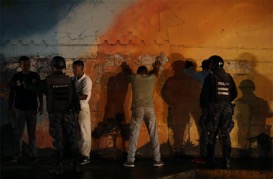
You say that there was “a deepening of everything that was already profoundly wrong”. What policies led to this? What transformations happened in police institutions under Chavismo, that would explain this rise in homicides at the hands of the police?
As I mentioned earlier, the decades of the 1960s, 1970s and 1980s were not a fairytale and Venezuela was not Disneyland. From 1998, and at least until the death of President Chávez, the dominant discourse in approaching the problem of public insecurity was one with a social focus. Starting in 2013, the Government’s discourse became much more repressive, ideologically very near to that of its alleged adversaries. Thus, we can clearly distinguish two stages in the discourse and the official policies regarding public safety in twenty-first century Venezuela.
A first stage can be identified between 1998 and 2013, beginning with the first government of President Chávez, who succeeded in capitalizing on the discontent with the political system as a whole. Chávez transformed that discontent into hope through a project that promised radical transformation and rupture with the previous order. This involved the “refoundation” of the Republic, a new Constitution, and a series of institutional reforms. The political and the social were the topics of discussion. “Public safety” was not on the agenda, and when it was broached, it ended up diluted in the discourse of social policies. The line was the classical social sciences Mertonian discourse: the lack of opportunities creates conditions for the most impoverished to commit crimes. What does this recipe call for, then? To improve their living conditions.
In consequence, the focus, apparently, was placed only on the social, on topics of inclusion, while neglecting attention to the spaces of security proper: the police forces, the Criminal Investigations Body (CICPC), the public prosecutors, the courts, and the prisons. All of these remained the same, unaffected by changes, following the same wrongful trajectories and progressively becoming power fiefs autonomous from the State itself. Though this was not a novelty of the Chávez government, the process became more acute, in a sort of continuity of a process of institutional precarization and decay.
In the field of legislation, the rationality of previous governments was maintained: increases in sentencing guidelines, decreases in welfare, broadened criminalization of behaviors, etc. Far from contributing to the improvement of the criminal justice system, all of this over-burdens it, making it slower and more arbitrary and violent.
From an ideological standpoint, it is important to highlight that the rhetoric of some allegedly progressive public opinion shapers, which attempts to trace a cause-effect link between poverty and violence, inadvertently coincides with classist, conservative and right-wing discourses, while seeming to superficially suggest that the State should only intervene socially. Critical criminology––especially its English strand–– began to overcome this idea towards the end of the 70s, and with it a romantic and idealized vision of the criminal: it set itself the task of analyzing, understanding and intervening in concrete criminal justice politics. This gave way to a more acute awareness of the fact that those most affected by violence and lack of safety are the most impoverished themselves, and that something must be done about this.
However, this was the discourse that President Chávez adopted from his rise to power to the day of his farewell. The causes of violence were understood to be factors associated with exclusion, inequality, poverty and lack of opportunities; as a consequence, the priority was to reduce these factors. Beyond the issue of public safety, what we must ask nowadays is whether in all those years, these needs were genuinely fulfilled in structural, universal, institutionalized, permanent, uninterrupted and non-conjunctural ways––if the purported Social State effectively came to be and if it achieved sustainability––or, on the contrary, if these changes were just another conjunctural redivision of the oil rent in times of abundance.
In terms of discourses, criminal justice politics during this period were seemingly dissolved into social policies, without heeding one of the great warnings of the [critical criminologist] Alessandro Baratta, namely, that public safety policies must be integrated into general social policies that encompass them. A public safety policy outside a framework of general social policies makes no sense. Social policies must not be confounded with public safety policies and social policies must not be ‘criminalized’ through their elaboration from security spaces. This is a very common error, and a very tempting one, for allegedly progressive approaches.
On the other hand, general social policies that do not guarantee the institutional presence of the State as mediator and intervenor in conflicts as a defender of the most vulnerable in situations that threaten or put at risk their enjoyment of their rights can suffer internal crises, as happened in the Venezuelan case.
The most emblematic concrete public safety policy during this early stage was the 2006 creation of the National Commission of Police Reform (CONAREPOL). This Commission was created in the context of an election year that coincided with a rise in homicides in the country, and with cases that shocked public opinion, Kennedy, Faddoul, Sindoni. [In reference to the murders of three university students in the Kennedy sector of Caracas, the murder of the businessman Filippo Sindoni, and the ransom kidnapping and murder of the Faddoul brothers, teenage sons of a Lebanese-Venezuelan businessman.] These cases, instrumentalized by the Opposition for electoral ends, involved police officers, and the high profile of the victims meant that the demands for justice around their cases gained plenty of steam.
What was the Government’s response to these demands? The CONAREPOL. The creation of this space was a correct political decision by the Government because, facing a crisis, it formed a consensus and exercised the elaboration of public policy in a serious and rational way. A new police model was designed, framed in legislation and in dozens of progressive resolutions between 2006 and 2013. With this impulse, a new institutionality was formed, in terms of narratives and forms. However, it is important to understand that the design of a policy is one thing and its implementation another. The police and military apparatuses maintain their own agendas, and have corporate, self-serving interests that any reform seeking to impose limits and institutional and legal controls upon their proceedings will affect.
Thus, while police reform was at the center of Government propaganda, in reality, a “counter-reform” by the State security forces was being carried out in the streets. This counter-reform, paradoxically, hid behind the “new model”, whose sets of norms were not applied. The ‘new model’ was useful to show off in times of crisis, to touch up the appearance of the police and to politically and socially re-legitimize it, and to refurbish its image in the press. Its merely discursive character served to invisibilize routine police practices that ended up becoming more and more dangerous and damaging. In terms borrowed from Robert K. Merton’s sociology, one could say that the process of police reform fulfilled a manifest function of designing a new police model, dignifying its service, and making it consistent with the protection of human rights and progressive goals. But the CONAREPOL had several latent functions: to cover up what was happening in reality and to oxygenate and expand the police apparatus, while deepening its discretionary powers and militaristic logics. The idea of a “civic-military union” never ceased to be present in how these institutions were to really operate.
With the death of President Chávez in 2013, the social discourse and focus were put aside, along with references to the civilian and preventive “new police model”, to begin a new stage that runs to our days. Right away a different discourse was taken up that put aside the more social perspective to mainly focus on aspects of repression. The new President [Maduro] took the topic of public safety as a central axis of his policies.
The governmental discourses and criminal justice policies took a radical turn, ideologically approaching the right-wing “realism” popularized towards the end of the 1980s by Reagan and Thatcher. With this turn, the poor were transformed from victims into victimizers, to be treated as ingrates who, in this view, insisted in committing crimes despite the Government’s social policies. Through the prism of a more conservative Left they are seen as “lumpen”, acting as an obstacle to the advance of the Revolution. These views would provide the ideological excuses for giving carte blanche to the military and the police to carry out a sort of “social cleansing” in which everyone who bears the features of ‘delinquency’ as promoted by classist and racist stereotypes must be neutralized through intimidation, incarceration or physical elimination.
The Government has changed its “enemies.” Earlier, it had all-powerful ones in “The Empire”, “Capitalism” and “the bourgeoisie.” Nowadays, the enemies are the barrio poor, the ingrate “lumpen.” Thus, an “anti-imperialist” “class struggle” has morphed into an intra-class struggle that criminalizes poverty. In this way, the Government has hardened its policies of police and military control. It carries out militarized police operations against marginal populations, with increasingly deadly consequences, as I described in the previous answer. The most recent examples of these are the Operations for the Liberation of the People (OLP) and the actions of the Special Action Force (FAES). Finally, the landscape of the past two decades confirms the existence of a structural problem in the continuity and follow-up of policies. In 58 years of “democracy”, Venezuela has had over 43 Ministers of the Interior [responsible for policies over police and public safety]. These, on average, don’t even last a year and a half in office. A consistent implementation of policies based on minimal institutional agreements that transcend the actors conjuncturally holding power cannot be found. The only continuity one can appreciate is the decay and corruption of the institutions that have recently reached new levels, increasing the vulnerability and defenselessness of citizens to institutional and criminal violence, which are more and more difficult to distinguish from one another.
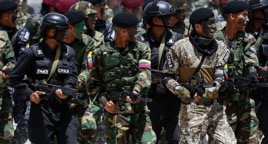
In what ways do social and economic indicators (such as access to education, healthcare, employment, housing, among others) evidence discrimination against oppressed groups?
Data and statistics in Venezuela are currently precarious. As I mentioned, the topic of racism has not been owned up to as a problem, so it is not addressed or registered.
According to the 2011 National Census, in terms of racial self-perception, only 2% of the population recognized themselves as ‘Black’ or ‘Afro-Descendant’, while 49% identified as ‘Brown’ [‘moreno/a’]. There is no consciousness of Blackness. This hinders the formation of strong organizations with anti-racist perspectives, as exist in the U.S. and Brazil. In consequence, debates, mobilizations and struggles in this sense are rare, having limited reach and impact.
Furthermore, in a context of a generalized crisis linked to the fulfillment of the most basic needs of the population, the ordering of priorities is also of a different nature. In Venezuela, over the past few years, social rights have severely regressed. The general scarcity of foodstuffs and medications correlates to the reappearance of diseases that were thought eradicated, such as malaria, diphtheria, measles, dengue fever, Chagas disease, meningitis, tetanus and tuberculosis. Over the past thirteen years, the currency has been deflated over 100 million times, reaching an inflation rate estimated at over 1 million percent, similar to Germany’s in 1923 or Zimbabwe’s in the 2000s. According to the National Survey of Living Conditions (ENCOVI), between 2014 and 2017, poverty by income increased from 48% to 87%, while extreme poverty grew from 23.6% to 61%. In the last yearly report of the UNDP, only Syria and Libya, two countries suffering from prolonged wars, have fallen farther in the Human Development Index than Venezuela, which fell 25 spots between 2012 and 2018. The most recent report of the World Food Program places us as number four in the world with the most ‘urgent need of aid’, with 9.3 million people, 32% of the population, suffering from food insecurity.
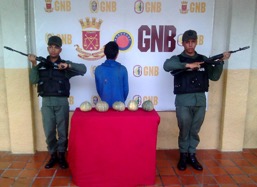
What movements are there in Venezuela today for racial justice, understood in broad terms? What dynamics do they take, what obstacles do they face?
As I stated earlier, I think in the country, in general terms, there is a greater consciousness of class than of race. I suspect that some of the few organizations that exist are promoted by the Government or have been coopted by it as part of its official propaganda apparatuses. This makes their field of discourse an action quite limited. But it would be better if you asked a specialist on the topic about this.

What consciousness is there in Venezuela about racism in the United States, the Black Lives Matter movement, and the on-going rebellion? What meaning do discussions about these take in the Venezuelan political context?
I’m thankful for this question, because it allows me to say several things I think are important, and that I don’t see addressed in public discussions.
Unfortunately, the national leadership has taken Venezuelans to a situation of increased defenselessness: the country is the object in imperialist disputes between the United States, Russia and China. This objectifies the country in different ways: for the great powers and for their ‘progressives’ it is a sort of laboratory where we as Venezuelans are the guinea pigs. At the same time, we find ourselves, in Foucaultian terms, in an enormous institution of reclusion.
In this context, it is not only useless but naive to attempt to reduce this complexity to dichotomous visions of Government-Opposition, or even more ridiculously, of Right-Left politics. In reality, despite the enormous and increasing rejection faced by the Government, the Opposition is almost non-existent. The Government plays alone in the national chess-board, and little remains in it of a Leftist character, beyond its aesthetics and the propaganda that some ––thankfully shrinking––sectors of a conservative left still consume, whether from lack of knowledge or from complicity.
Thus, we see sectors that condemn police violence in the U.S., but legitimize and justify the slaughters that security forces carry out in Venezuela. These sectors are mirrored by those who justify police violence in the U.S. but vehemently condemn it in Venezuela. In the end, the fans of Trump and Maduro are quite similar on these topics as they both follow structurally authoritarian, repressive and anti-democratic projects. They may define themselves as antagonistic, but they rather complement and legitimize each other, using one another’s excesses in their propaganda to cover up or justify their own crimes.
In Venezuela, for instance, the Government uses the terrible case of George Floyd in its tirades and propaganda against the U.S. government, with the end of seducing some well-meaning dupes among international progressives. With this, they distract attention from the disaster that they have made in the country and the massacres that their own security bodies execute.
On the side of the more traditional Opposition, Black Lives Matter will not be well received because, in the end, these are conservative, racist and classist sectors that agree with this type of excess against the excluded; they will only raise their voices when the victims are their own militants, middle-class youth in the context of a political demonstration, or when it is beneficial for their own media agenda. They care very little about the deaths of thousands of racialized and impoverished young people caused by police interventions.
As I mentioned earlier, I think that race consciousness is still in a state of gestation in Venezuela. The Left in our country is predominantly and majoritarily conservative and Eurocentric; it does not ask itself these questions because race does not fit well in its cheat-sheet of “class struggle”. Moreover, much of it is in a process of self-destruction, having been co/opted by the Government’s apparatuses, logics, and rhetoric––hence their oscillation between justifications, denying reality, and an abetting silence towards the State’s excesses and human rights violations. Only minority sectors, with little weight, remain active in struggle. Fortunately, the international left and progressive sectors are becoming increasingly aware of what is really happening in Venezuela, and little by little have been putting aside automatic solidarities towards its Government.
Institutional violence and human rights violations must always be energetically condemned. There are no good violators of human rights, and their behaviors should not be justified in any way. This double standard to condemn some excesses and justify others does enormous harm to societies and states, and to politics itself.
